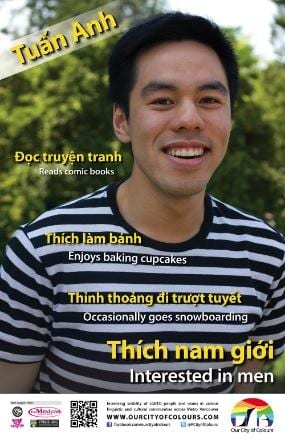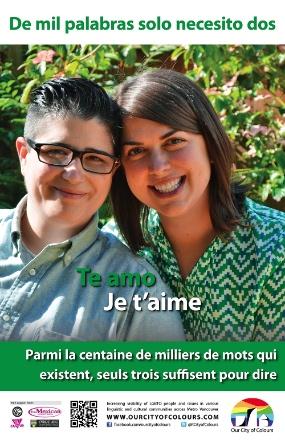“Our posters are aimed at those who still believe that homosexuality and queerness is a Western issue,” says Darren Ho, co-founder of Our City of Colours, which launched its latest campaign Oct 9.
“But also, our posters are aimed to add to the insufficient amount of positive and friendly images which reflect our cultural differences within queer communities,” he says. “Essentially, our posters are aimed towards removing stigmatization in a multitude of communities.”
Our City of Colours launched in November 2011 with six posters featuring eight models from the Chinese, Iranian and Punjabi communities. Each poster included written descriptions in English and in the models’ respective languages.
Ho says the latest campaign, featuring posters in Tagalog, Spanish, Vietnamese, French and Russian, is as essential now as the first one was a year ago.
“Our goal to increase the visibility of LGBTQ people in various linguistic and cultural communities will always be relevant as long as homosexuality continues to be a taboo subject in some communities, and as long as queer people from these communities continue to be misrepresented and under-represented in the mainstream media,” he says.
While it’s hard to gauge the precise impact the posters have had on the communities they’ve tried to reach, Ho says Our City of Colours has received many supportive emails.
“Of course, we never really hear from those who think otherwise,” he acknowledges. “Having said that, I think the previous campaign was successful in voicing the need for more representation of people from diverse communities.”
The first campaign was also successful at bringing together a diverse group of people to work on the project, he notes. “We’ve now built a solid foundation to continue working for this cause.”
Already the new posters have attracted more than 800 “likes” and at least 320 “shares” on the group’s Facebook page, as well as many appreciative comments.
Ho recalls an email he received from a young man who particularly appreciated a poster of two Asian Canadian men holding hands. The writer thanked Ho and Our City of Colours and said he was touched by the poster’s depiction of an image rarely found in mainstream North American media.
Ho, who is of Chinese background, has gone through his own struggle of balancing his sexuality with a sense of guilt toward his family. “When I get messages like this one, I feel proud of the work that I’m doing, proud that Our City of Colours exists,” he says.
“I feel a sense of comfort in knowing that others have gone through similar struggles that I have faced, and still face,” he adds.



 Why you can trust Xtra
Why you can trust Xtra


